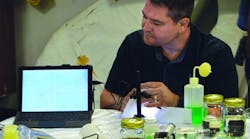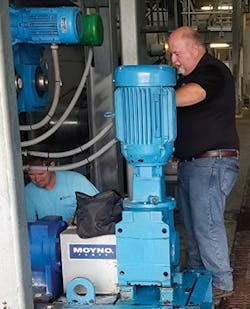Sensors, made more cost-effective because of the industrial internet of things (IIoT), do not eliminate the need for plant personnel to use their own senses and knowledge to assess and dig deeper. In addition, many assets may not be equipped with sensor technology. For those machines, the only assessment tools are the knowledge and senses of the engineers, technicians, operators, and other personnel. Even when equipment is “sensored up,” personnel may ignore or not use the data they receive.
During the onboarding of new employees, learning or refreshing basic knowledge is often ignored. When engineers graduate from college, they have spent years studying and gaining knowledge in their field. However, some of the simple, basic skills typically learned on the job may not be taught. Some in-the-field tests are simple for personnel to perform, using materials on hand, their senses, and their experience.
1. Collect overall temperature
Increased temperature is often an early indicator of problems. An established, high-level temperature alarm (for example, a reading higher than 150°F) allows for a quick decision about an asset’s health or whether operation of the machine can continue. Looking at an overall profile of the asset and comparing it to similar ones may help in determining the origin or root cause of the temperature anomalies.
A quick asset scan with inexpensive instruments can reveal abnormal temperatures. If a temperature issue is suspected, any of these tools can help:
- digital thermometer
- thermocouple
- pyrometer
- thermistor meter
- infrared camera (some available on a cell phone).
If the temperature rises above the predetermined limit, the team can then examine the asset to investigate why the temperature increased.
2. Examine your lubricants
Oil analysis prevents many equipment issues, if contamination is caught early before bearing damage. While sophisticated oil testing capabilities are valuable and available, they may not be necessary to find and categorize contamination. Many visual indicators and simple oil field tests can be helpful. Lubrication systems come with many visual indicators, including sight glasses and pressure gauges.
Additionally, some simple field tests can help identify contamination problems. A quick glance at a sight glass gives lots of information about the lubricant’s condition. This allows personnel to obtain information about the oil including:
- volume
- level
- color
- water emulsion
- aeration
- foam.
The ideal lubricant level should be marked on the glass to simplify level checks.
A differential pressure gauge will indicate potential lubrication problems. The first is when a filter needs to be changed because it can no longer filter as it should. Pressure changes alert personnel when it’s time to replace the filter. Gauges may also indicate blockages in the system.
Other simple field tests may be carried out with minimal time and few materials. Some tests for water, ferrous wear particles, and nonferrous wear particles may prevent many lubrication failures.
A crackle test, for example, detects water and other contaminants on-site. A hotplate and a dropper or syringe are the only items required. Set the hot plate temperature to 320°F (160°C). This must always be the same. Auditory (a crackle) and visual (small bubbles) signs may indicate water contamination. If this occurs, consider further analysis.
Another test is collecting an oil sample for visual inspection. Separation of the fluid often reveals water in the oil. However, it may also indicate that the wrong oil was added, which may cause the two different oils to separate. With the visual test, also look for insoluble specks. Sedimented particles will drop and settle to the bottom. At the same time, check the lubricant’s clarity. Is the oil clear and bright? Can you read text through it? If the lubricant is dark, this may indicate a need for an oil change. Oil may darken over time because of oxidation.
Perform a magnet test to look for metallic particles. With the small size of a magnet, this test is also a simple way to look for potential problems. Stir the oil with the magnet, and check for any ferrous particles that will adhere to it.
Finally, if you want to add some technology, purchase an inexpensive microscope to have in your tool box. With this and your laptop, you can get up close and personal with your contaminants (see Figure 1), including checking out your new, clean oil, which is usually not very clean at all and should be filtered before use.
3. Use your ears
Many plants are making the move from reactive to preventive and predictive maintenance strategies. Because of this, sensors added to or included in equipment provide a wealth of information about the asset’s health. While this automatic data is welcome and needed, not all machines have sensors. Many assets lower on the hierarchy will never be equipped with sensors. For this reason, teams must continue to rely on their senses.
Figure 2. A technician examines a pump system at a wastewater treatment plant.
Plant personnel who have worked in a facility for years know how operations typically sound (see Figure 2). When something sounds different, they may notice. Machines talk. The plant team just needs to learn the language. When they tune their ears to focus on the equipment, they may hear problems such as:
- cavitation
- rattling check valves
- the squeal of worn belts
- the frictional rubbing of components.
4. Conduct visual inspections
To provide important information and feedback, visual inspections are the foundation of equipment maintenance. Team members walking the plant floor have the best chance to notice these issue indicators.
Figure 3. Gypsum visibly leaks at a drywall manufacturing plant.
As technology continues to evolve, some personnel may find themselves focused on a screen displaying the output of a sensor or multiple sensors. While observing this screen, they may miss an issue with one part of the system. Plant teams must remember that they are looking at a system of machine components that operate together to perform a desired process function and must also observe the whole system (see Figure 3).
In most circumstances, a sensor is attached to one component via one point. While a sensor may provide higher sensitivity than human senses, it may also be limited by the location and direction of the data it provides. With the exception of using multiple sensors to collect data that builds a model of the machine system, the advantage of observing the whole system goes to the human.
Some of these visual issues include:
- worn belts
- vibration or movement of the equipment; loose or vibrating piping
- low levels of oil or process fluids
- lubrication or process leaks
- cracks/breaks in assets
- baseplate warps or other abnormalities.
Quick field assessments
The IIoT gives industrial personnel vast data to determine the health of equipment in a plant. However, value remains in using simple-to-conduct field tests and your senses. Without experienced professionals making quick field assessments, some assets without sensors could fail, incurring downtime and related costs. Simple tools, knowledge, experience, and senses may detect problems before asset failure.
Chris Tindell, CMRP, is a regional business manager for Sealing Equipment Products Company. A reliability leader in the fluid sealing industry, SEPCO supports global distribution in more than 30 countries. Tindell is a maintenance and reliability professional with more than 20 years of experience in reliability consulting, training, and troubleshooting equipment. He is an experienced vibration and lubrication analyst and maintains professional certifications in multiple engineering technology fields. Tindell has worked in many manufacturing industries auditing and optimizing PSM maintenance programs and providing training on RCM and Lean manufacturing strategies.



